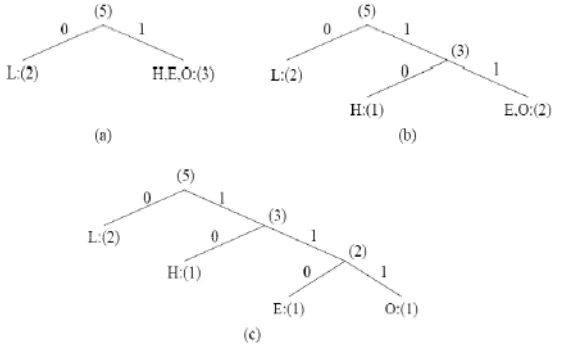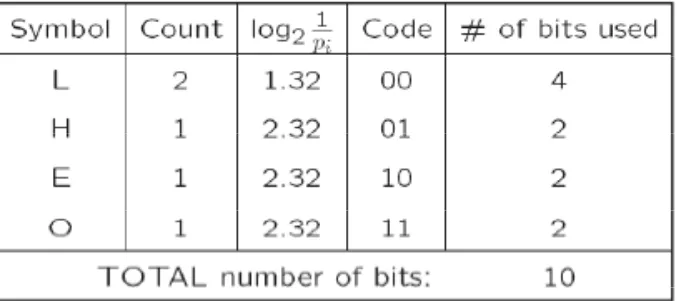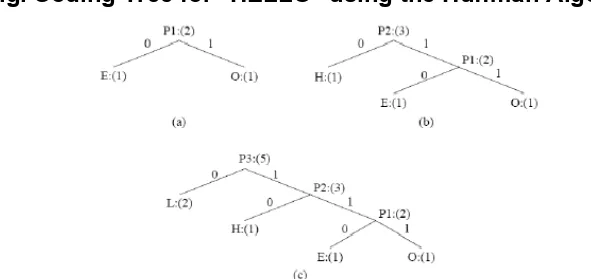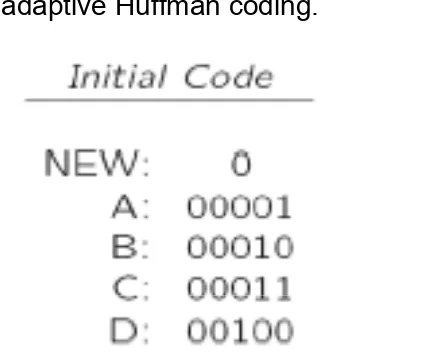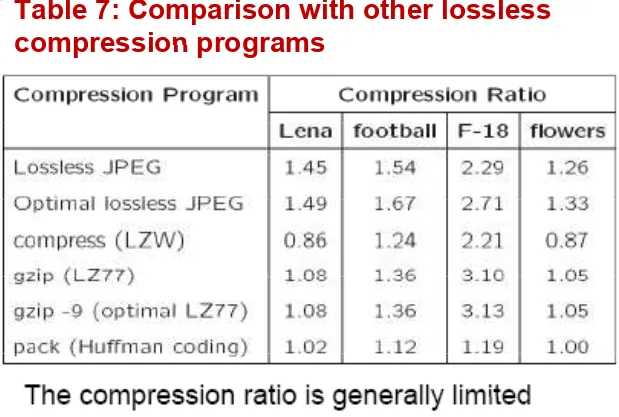Unit VI
M lti
di d t
i
Multimedia data compression
Lossless compression algorithm
L
i
l
ith
Introduction
Compression: The process of coding that will effectively
Compression: The process of coding that will effectively reduce the total number of bits needed to represent certain information.
If the compression and decompression processes induce no
A General Data Compression Scheme
If the compression and decompression processes induce no information loss, then the compression scheme is lossless; otherwise, it is lossy.
Basics of Information Theory
y
The entropy η of an information source with alphabet S = {s1,s2,...,sn} is:
Æ 2
Distribution of Gray-Level Intensities
Histograms for Two Gray-level Images Histograms for Two Gray-level Images.
Fig (a) shows the histogram of an image with uniform distribution of gray-level intensities, i.e.,
Hence, the entropy of this image is:
Entropy and Code Length
py
g
As can be seen in Eq (3): the entropy η is a weighted-sum of terms ; hence it represents the average amount of
i f ti t i d b l i th S
information contained per symbol in the source S.
The entropy η specifies the lower bound for the average number of bits to code each symbol in S, i.e.,
number of bits to code each symbol in S, i.e.,
-the average length (measured in bits) of the codewords produced by the encoder
(a)η=8 the minimum average (a)η=8, the minimum average
number of bits to represent each gray-level intensity is at least 8 (b)η=(1/3)log23 + (2/3)log2(3/2)=0 92 (b)η (1/3)log23 + (2/3)log2(3/2) 0.92
Run Length Coding
g
g
Memoryless Source:
an information source that is
independently distributed. Namely, the value of the
current symbol does not depend on the values of the
previously appeared symbols.
I
t
d f
i
l
R
Instead of assuming memoryless source,
Run-Length Coding (RLC)
exploits memory present in
the information source
the information source.
Rationale for RLC
: if the information source has the
property that symbols tend to form continuous
property that symbols tend to form continuous
groups, then such symbol and the length of the
group can be coded.
Variable Variable Length Coding (VLC)
g
g (
)
Shannon-Fano Algorithm — a top-down approach
1. Sort the symbols according to the frequency count of their occurrences.
2. Recursively divide the symbols into two parts, each with approximately the same number of counts until all parts approximately the same number of counts, until all parts contain only one symbol.
Huffman Coding
ALGORITHM Huffman Coding Algorithm — a bottom-up approach
1 I iti li ti P t ll b l li t t d di t th i 1. Initialization: Put all symbols on a list sorted according to their
frequency counts.
2. Repeat until the list has only one symbol left: 2. Repeat until the list has only one symbol left:
1) From the list pick two symbols with the lowest frequency counts. Form a Huffman subtree that has these two
b l hild d d t t d
symbols as child nodes and create a parent node.
2) Assign the sum of the children's frequency counts to the parent and insert it into the list such that the order is
parent and insert it into the list such that the order is maintained.
3) Delete the children from the list
Fig. Coding Tree for "HELLO" using the Huffman Algorithm.
In Fig new symbols P1, P2, P3 are created to refer to the parent nodes in the Huffman coding tree The contents in the list are illustrated:
Properties of Huffman Coding
p
g
1. Unique Prefix Property: No Huffman code is a prefix of any other Huffman code -precludes any ambiguity in decoding.p y g y g
2. Optimality: minimum redundancy code –proved optimal for a given data model (i.e., a given, accurate, probability
distrib tion) distribution):
– The two least frequent symbols will have the same length for their Huffman codes, differing only at the last bit., g y
– Symbols that occur more frequently will have shorter Huffman codes than symbols that occur less frequently. – The average code length for an information source S is strictly less than η+ 1. Combined with Eq. (5), we have:
Extended Huffman Coding
Motivation: All codewords in Huffman coding have integer bit lengths. It is wasteful when pi is very large and hence
i l t 0 is close to 0.
Why not group several symbols together and assign a single codeword to the group as a whole?
codeword to the group as a whole?
It can be proven that the average # of bits for each symbol is:
Æ 7
An improvement over the original Huffman coding, but not much.
much.
Problem: If k is relatively large (e g k≥ 3) e.g., 3), then for most practical applications where n>> 1, nk implies a huge
b l t bl i ti l
Adaptive Huffman Coding
Initial assigns symbols with some Initial_code
i iti ll
d
d
ith
t
i
initially agreed upon codes, without any prior
knowledge of the frequency counts.
Update tree constructs an Adaptive Human
tree.
It basically does two things:
a) increments the frequency counts for the
a) increments the frequency counts for the
symbols (including any new ones).
b) updates the configuration of the tree
b) updates the configuration of the tree.
The encoder and decoder must use exactly
th
i iti l
d
d
d t
t
Notes on Adaptive Human Tree Updating (*)
f
f
Nodes are numbered in order from left to right,
bottom to top. The numbers in parentheses
i di
t
th
t
indicates the count.
The tree must always maintain its sibling
t
i
ll
d
(i t
l
d l
f)
property, i.e., all nodes (internal and leaf) are
arranged in the order of increasing counts.
If th
ibli
t i
b
t t b
i l t d
If the sibling property is about to be violated, a
swap procedure is invoked to update the tree by
rearranging the nodes
Another Example: Adaptive Huffman Coding
p
p
g
This is to clearly illustrate more
implementation details We show exactly sent
implementation details. We show exactly sent
to simply what bits are sent, as opposed
stating how the tree is updated
stating how the tree is updated.
An additional rule: if any character/symbol is
t b
t th fi t ti
it
t b
d d
to be sent the first time, it must be preceded
by a special symbol NEW The initial code
b l NEW f
NEW i 0 Th
t f
Table 7.4 Sequence of symbols and codes sent to the decoder
It is important to emphasize that the code for a particular
It is important to emphasize that the code for a particular symbol changes during the adaptive Huffman coding
process.
For example, after AADCCDD, when character D overtakes A as the most frequent symbol, its code changes from 101 to 0.
Dictionary based Coding
LZW fi d l th d d t fi d t
LZW uses fixed-length codewords to fixed represent
variable-length strings of symbols/characters that commonly occur together, e.g., words in English text.g g g
the LZW encoder and decoder build up the same dictionary dynamically while receiving the data.
LZW l l d l d i i
LZW places longer and longer repeated entries into a
dictionary, and then emits the code for an element rather than the string element, itself, if the element has already g , , y been placed in the dictionary.
The predecessors of LZW are LZ77 and LZ78, due to Jacob Zi and Abraham Lempel in 1977 and 1978
Jacob Ziv and Abraham Lempel in 1977 and 1978.
Terry Welch improved the technique in 1984.
LZW is used in many applications such as UNIX compress
Example 2 LZW compression for string “ABABBABCABABBA”
• Let's start with a very simple dictionary (also referred
"table") initially containing only 3 characters with codes astable ) initially containing only 3 characters, with codes as follows:
Now the input string is ABABBABCABABBA” the LZW
Arithmetic Coding
Arithmetic coding is a more modern coding method that usually out-performs Huffman coding.
Huffman coding assigns each symbol a codeword
which has an integral bit length. Arithmetic coding can treat the whole message as one unit
treat the whole message as one unit.
A message is represented by a half-open interval [a, b) where a and b are real numbers between 0 and 1.
Initially, the interval is [0, 1). When the message
becomes longer the length of the interval shortens and the number of bits needed to represent the interval
Example: Encoding in Arithmetic Coding
PROCEDURE 2 Generating Codeword for Encoder
The final step in Arithmetic encoding calls for the generation of a number that falls within the range [low, high). The above algorithm will ensure that the
Lossless Image Compression
Approaches of Differential Coding of Images:
– Given an original image I(x, y), using a simple difference operator we can define a difference image d(x y) as
operator we can define a difference image d(x, y) as follows:
d(x, y)= I(x, y) − I(x − 1,y) Æ 9
or use the discrete version of the 2-D Laplacian operator to define a difference image d(x, y) as
d( ) 4 I( ) I( 1) I( 1) I( 1 ) I( d(x, y)=4 I(x, y) − I(x, y − 1) − I(x, y +1) − I(x +1,y) − I(x −
1,y) Æ 10
Due to spatial redundancy existed in normal images I, the
Due to spatial redundancy existed in normal images I, the difference image d will have a narrower histogram and
Lossless JPEG
Lossless JPEG: A special case of the JPEG image
Lossless JPEG: A special case of the JPEG image compression.
The Predictive method
1. Forming a differential prediction: A predictor combines the values of up to three neighboring pixels as the
predicted value for the current pixel indicated by 'X' in predicted value for the current pixel, indicated by 'X' in Fig. 10. The predictor can use any one of the seven schemes listed in Table 6.
2. Encoding: The encoder compares the prediction with the actual pixel value at the position `X' and encodes the difference using one of the lossless compression
difference using one of the lossless compression
Fig 10: Neighboring Pixels for Predictors in Lossless JPEG
Note: Any of A, B, or C has already been decoded before it is used in the predictor, on the decoder side of an
Table 7: Comparison with other lossless
compression programs
Introduction
Lossless compression algorithms do not deliver compression ratios that are high enough. Hence, most multimedia
compression algorithms are lossy. compression algorithms are lossy.
What is lossy compression ?
– The compressed data is not the same as the original data, but a close approximation of it.
– Yields a much higher compression ratio than that of lossless compression
The Rate-Distortion Theory
Provides a framework for the study of
Quantization
Reduce the number of distinct output
values to a much smaller set.
Main source of the “loss” in lossy
compression.
p
Three different forms of quantization.
Uniform: midrise and midtread quantizers
– Uniform: midrise and midtread quantizers.
– Nonuniform: companded quantizer.
Uniform Scalar Quantization
A uniform scalar quantizer partitions the domain of
input values into equally spaced intervals, except
ibl
t th t
t
i t
l
possibly at the two outer intervals.
– The output or reconstruction value corresponding to
each interval is taken to be the midpoint of the
each interval is taken to be the midpoint of the
interval.
– The length of each interval is referred to as the
g
step
p
size, denoted by
the symbol
∆
.
Two types of uniform scalar quantizers:
Companded quantization is
nonlinear.
As shown above, a compander consists of
a compressor function G, a uniform
quantizer, and an expander function G
−1.
The two commonly used companders are
y
p
Vector Quantization (VQ)
According to Shannon’s original work on
information theory, any compression system
performs better if it operates on vectors or groups
of samples rather than individual symbols or
samples
samples.
Form vectors of input samples by simply
concatenating a
number of consecutive samples
concatenating a
number of consecutive samples
into a single vector.
Instead of single reconstruction values as in scalar
Instead of single reconstruction values as in scalar
Transform Coding
The rationale behind transform coding:
If Y is the result of a linear transform T of the input
t
X i
h
th t th
t
f Y
vector X in such a way that the components of Y are
much less correlated, then Y can be coded more
efficiently than X.
efficiently than X.
If most information is accurately described by the first
few
components of a transformed vector, then the
remaining components can be coarsely quantized, or
even set to zero, with little signal distortion.
Di
t C
i
T
f
(DCT)
ill b
t di d fi t
Discrete Cosine Transform (DCT) will be studied first.
Spatial Frequency and DCT
Spatial frequency indicates how many times pixel
values
change across an image block.
The DCT formalizes this notion with a measure of
how much
the image contents change in
correspondence to the number of cycles of a cosine
correspondence to the number of cycles of a cosine
wave per block.
